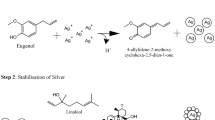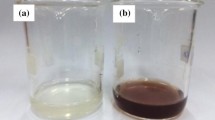Abstract
Development of novel wound dressing with potent antibacterial activity is crucial for wound healing and tissue regeneration. In this work, we aim to prepare silver nanoparticles (AgNPs)-doped collagen–alginate (CA–AgNPs) biocomposite, which may possess antibacterial activity and be used as wound dressing. AgNPs were synthesized using NaBH4 as reducing agent and polyvinyl pyrrolidone as stabilizing agent. The formation of the AgNPs was confirmed by ultraviolet–visible spectrophotometer and transmission electron microscopy. Then, the as-prepared AgNPs were mixed with sodium alginate and collagen to obtain CA–AgNPs biocomposite. The CA–AgNPs biocomposite was fully characterized to verify the presence of AgNPs in the biocomposite. In vitro cytotoxicity assay illustrated that the CA–AgNPs biocomposite possessed negligible cytotoxicity at low AgNPs concentration. Furthermore, the antibacterial activity of the CA–AgNPs biocomposite was assessed against Staphylococcus aureus and Escherichia coli through agar diffusion method. Inhibition zone indicated that CA–AgNPs biocomposite possessed much higher antimicrobial activity than that of CA biocomposite, which strengthened with the increase in the AgNPs contents. Taken together, our finding suggested that the CA–AgNPs biocomposite showed strong potential as wound dressing.








Similar content being viewed by others

References
Balasubramani M, Kumar TR, Babu M (2001) Skin substitutes: a review. Burns 27:534–544
You C, Li Q, Wang X et al (2017) Silver nanoparticle loaded collagen/chitosan scaffolds promote wound healing via regulating fibroblast migration and macrophage activation. Sci Rep 7:10489
Ma Y, Xin L, Tan H et al (2017) Chitosan membrane dressings toughened by glycerol to load antibacterial drugs for wound healing. Mat Sci Eng C Mater 81:522–531
Khor E, Lim LY (2003) Implantable applications of chitin and chitosan. Biomaterials 24:2339–2349
Loke WK, Lau SK, Yong LL, Khor E, Sum CK (2000) Wound dressing with sustained anti-microbial capability. J Biomed Mater Res 53:8–17
Jayakumar R, Prabaharan M, Kumar PTS, Nair SV, Tamura H (2011) Biomaterials based on chitin and chitosan in wound dressing applications. Biotechnol Adv 29:322–337
Xie H, Chen X, Shen X et al (2018) Preparation of chitosan–collagen–alginate composite dressing and its promoting effects on wound healing. Int J Biol Macromol 107:93–104
Michalska-Sionkowska M, Walczak M, Sionkowska A (2017) Antimicrobial activity of collagen material with thymol addition for potential application as wound dressing. Polym Test 63:360–366
Pal S, Nisi R, Stoppa M, Licciulli A (2017) Silver-functionalized bacterial cellulose as antibacterial membrane for wound-healing applications. ACS Omega 2:3632–3639
Dowling MB, Chaturvedi A, MacIntire IC et al (2016) Determination of efficacy of a novel alginate dressing in a lethal arterial injury model in swine. Injury 47:2105–2109
Ye J, Shi X, Chen X et al (2014) Chitosan-modified, collagen-based biomimetic nanofibrous membranes as selective cell adhering wound dressings in the treatment of chemically burned corneas. J Mater Chem B 2:4226–4236
Baniasadi M, Minary-Jolandan M (2015) Alginate–collagen fibril composite hydrogel. Materials (Basel) 8:799–814
Lee BR, Hwang JW, Choi YY, Wong SF, Hwang YH, Lee DY, Lee SH (2012) In situ formation and collagen–alginate composite encapsulation of pancreatic islet spheroids. Biomaterials 33:837–845
Lee H-j, Ahn S-H, Kim GH (2011) Three-dimensional collagen/alginate hybrid scaffolds functionalized with a drug delivery system (DDS) for bone tissue regeneration. Chem Mater 24:881–891
Bakare RA, Bhan C, Raghavan D (2014) Synthesis and characterization of collagen grafted poly(hydroxybutyrate-valerate) (PHBV) scaffold for loading of bovine serum albumin capped silver (Ag/BSA) nanoparticles in the potential use of tissue engineering application. Biomacromolecules 15:423–435
GhavamiNejad A, Rajan Unnithan A, Ramachandra Kurup Sasikala A et al (2015) Mussel-inspired electrospun nanofibers functionalized with size-controlled silver nanoparticles for wound dressing application. ACS Appl Mater Interfaces 7:12176–12183
Fei X, Jia M, Du X et al (2013) Green synthesis of silk fibroin–silver nanoparticle composites with effective antibacterial and biofilm-disrupting properties. Biomacromolecules 14:4483–4488
Lee HY, Park HK, Lee YM, Kim K, Park SB (2007) A practical procedure for producing silver nanocoated fabric and its antibacterial evaluation for biomedical applications. Chem Commun 28:2959–2961
Bao H, Yu X, Xu C, Li X, Li Z, Wei D, Liu Y (2015) New toxicity mechanism of silver nanoparticles: promoting apoptosis and inhibiting proliferation. PLoS ONE 10:e0122535
Paladini F, Pollini M, Sannino A, Ambrosio L (2015) Metal-based antibacterial substrates for biomedical applications. Biomacromolecules 16:1873–1885
Gopinath V, Velusamy P (2013) Extracellular biosynthesis of silver nanoparticles using Bacillus sp GP-23 and evaluation of their antifungal activity towards Fusarium oxysporum. Spectrochim Acta A Mol Biomol Spectrosc 106:170–174
Zhao X, Li Q, Ma X, Quan F, Wang J, Xia Y (2015) The preparation of alginate–AgNPs composite fiber with green approach and its antibacterial activity. J Ind Eng Chem 24:188–195
Tsuji M, Gomi S, Maeda Y et al (2012) Rapid transformation from spherical nanoparticles, nanorods, cubes, or bipyramids to triangular prisms of silver with PVP, citrate, and H2O2. Langmuir 28:8845–8861
Sarkar AK, Saha A, Midya L, Banerjee C, Mandre N, Panda AB, Pal S (2017) Cross-linked biopolymer stabilized exfoliated titanate nanosheet-supported AgNPs: a green sustainable ternary nanocomposite hydrogel for catalytic and antimicrobial activity. ACS Sustain Chem Eng 5:1881–1891
Goli KK, Gera N, Liu X, Rao BM, Rojas OJ, Genzer J (2013) Generation and properties of antibacterial coatings based on electrostatic attachment of silver nanoparticles to protein-coated polypropylene fibers. ACS Appl Mater Interfaces 5:5298–5306
Chook SW, Chia CH, Zakaria S, Neoh HM, Jamal R (2017) Effective immobilization of silver nanoparticles on a regenerated cellulose–chitosan composite membrane and its antibacterial activity. New J Chem 41:5061–5065
Goli KK, Gera N, Liu X, Rao BM, Rojas OJ, Genzer J (2013) Generation and properties of antibacterial coatings based on electrostatic attachment of silver nanoparticles to protein-coated polypropylene fibers. ACS Appl Mater Interfaces 5:5298–5306
Tejamaya M, Roemer I, Merrifield RC, Lead JR (2012) Stability of citrate, PVP, and PEG coated silver nanoparticles in ecotoxicology media. Environ Sci Technol 46:7011–7017
Venkatesan J, Lee JY, Kang DS, Anil S, Kim SK, Shim MS, Kim DG (2017) Antimicrobial and anticancer activities of porous chitosan–alginate biosynthesized silver nanoparticles. Int J Biol Macromol 98:515–525
Iqbal B, Muhammad N, Jamal A et al (2017) An application of ionic liquid for preparation of homogeneous collagen and alginate hydrogels for skin dressing. J Mol Liq 243:720–725
Zeng M, Xiao H, Zhang X, Sun X, Qi C, Wang B (2011) A novel chitosan/polyvinyl pyrrolidone (CS/PVP) three-dimensional composite and its mechanism of strength improvement. J Macromol Sci Part B Phys 50:1413–1422
Ahamed MI, Sankar S, Kashif PM, Basha SK, Sastry TP (2015) Evaluation of biomaterial containing regenerated cellulose and chitosan incorporated with silver nanoparticles. Int J Biol Macromol 72:680–686
Lin S, Chen L, Huang L, Cao S, Luo X, Liu K (2015) Novel antimicrobial chitosan–cellulose composite films bioconjugated with silver nanoparticles. Ind Crop Prod 70:395–403
Acknowledgements
This work was supported by Natural Science Foundation of Jiangsu Province (BK 20170202, BK 20170203) and National Natural Science of China (21574059, 81503007). This work was also supported by national first-class discipline program of Light Industry Technology and Engineering (LITE2018-20).
Author information
Authors and Affiliations
Corresponding authors
Rights and permissions
About this article
Cite this article
Zhang, H., Peng, M., Cheng, T. et al. Silver nanoparticles-doped collagen–alginate antimicrobial biocomposite as potential wound dressing. J Mater Sci 53, 14944–14952 (2018). https://doi.org/10.1007/s10853-018-2710-9
Received:
Accepted:
Published:
Issue Date:
DOI: https://doi.org/10.1007/s10853-018-2710-9



